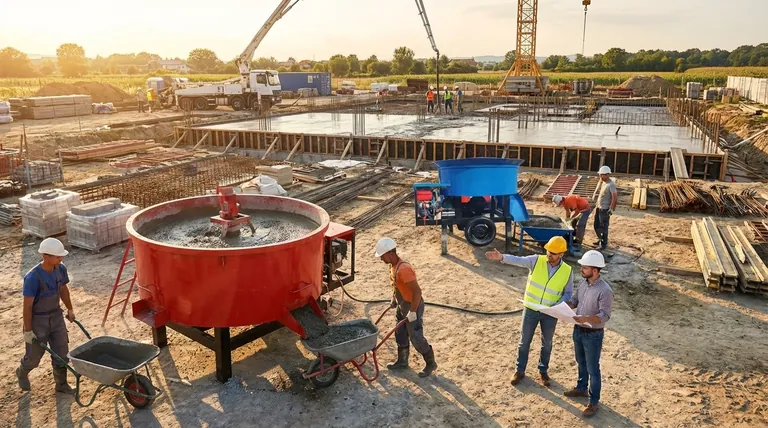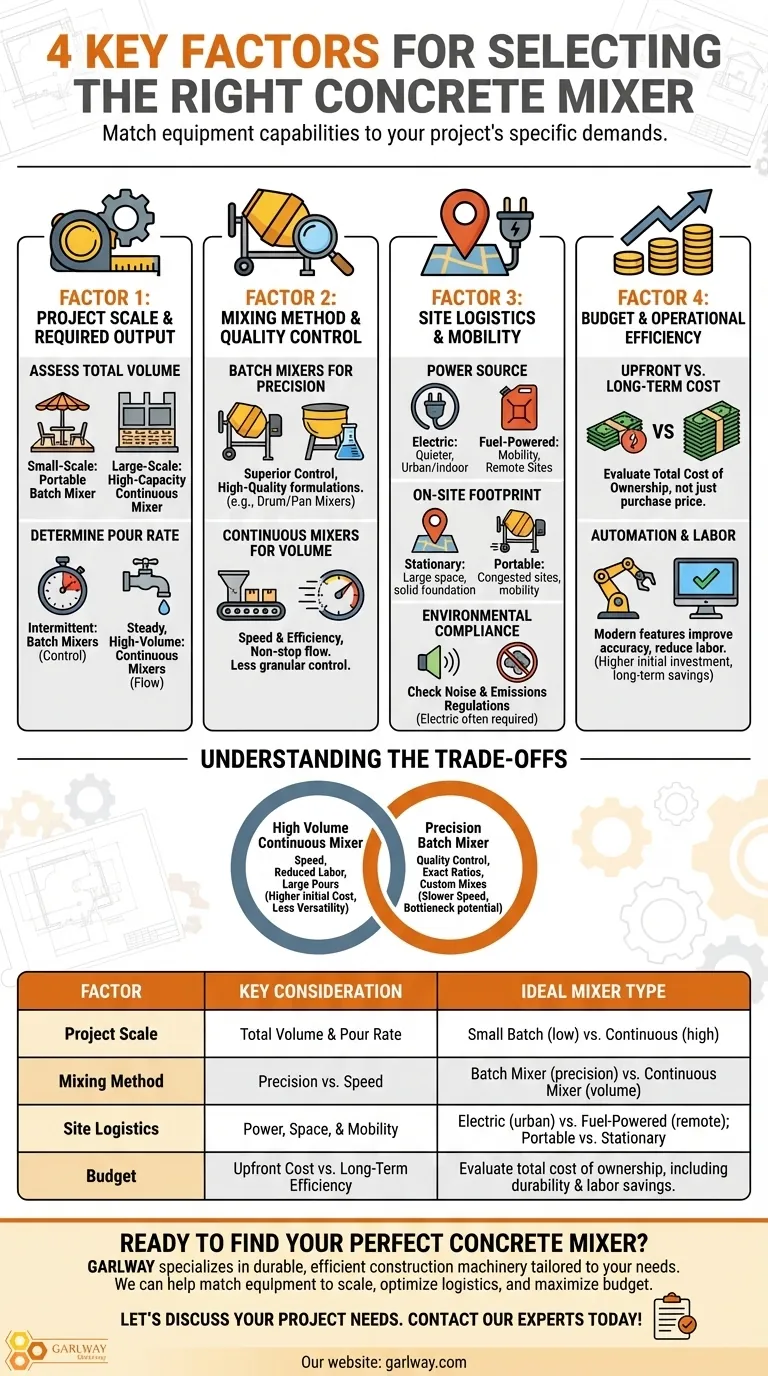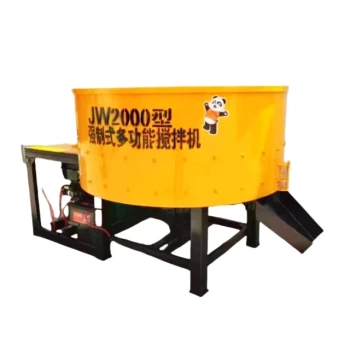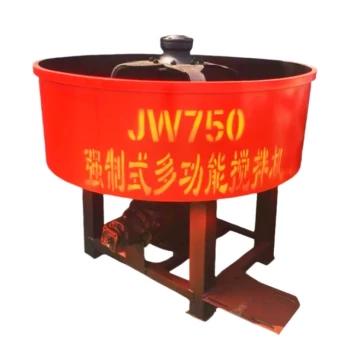Selecting the right concrete mixer is a critical decision that directly impacts project timelines, budget, and structural integrity. The four primary factors you must consider are project scale, required mixing method, site logistics, and overall budget. These elements work together to determine whether you need a high-volume continuous mixer for a large foundation or a precise, portable batch mixer for specialized repair work.
The core principle is not to find the "best" mixer, but to match the equipment's capabilities—its capacity, precision, and mobility—to the specific demands of your construction project. An incorrect choice leads to inefficiency, wasted materials, and potential compromises in concrete quality.

Factor 1: Project Scale and Required Output
Your project's size is the most fundamental factor. It dictates both the total volume of concrete you will need and the rate at which you need it.
Assess the Total Concrete Volume
For small-scale projects like residential patios or repairs, a smaller portable batch mixer is sufficient. Large-scale commercial or infrastructure projects, however, demand high-capacity stationary or continuous mixers to produce the necessary volume without causing delays.
Determine the Required Pour Rate
Consider whether the job requires a steady, high-volume flow of concrete or intermittent, controlled pours. A continuous mixer is built for the former, making it ideal for large slabs or foundations. Batch mixers are designed for the latter, giving you control over individual loads.
Factor 2: Mixing Method and Quality Control
The type of mixer directly correlates with the level of control you have over the concrete mix. The choice between batch and continuous systems is central to this.
Batch Mixers for Precision
Batch mixers produce concrete one load at a time. This method offers superior control over mix ratios, making it essential for projects requiring specific, high-quality concrete formulations. Types include drum and pan mixers, which are valued for their consistency.
Continuous Mixers for Volume
Continuous mixers are designed for speed and efficiency. They are fed raw materials constantly and produce a non-stop flow of concrete. While highly effective for massive projects, they offer less granular control over individual mix proportions compared to batch systems.
Factor 3: Site Logistics and Mobility
The physical environment of your building site imposes practical constraints that can immediately disqualify certain types of mixers.
Power Source Availability
Your choice is primarily between electric and fuel-powered mixers. Electric mixers are quieter and produce no emissions but require a reliable power source. Fuel-powered (diesel or gas) mixers offer greater mobility and are necessary for remote sites without grid access.
On-Site Footprint and Accessibility
A large, stationary mixer requires significant space and a solid foundation. If your site is congested or requires moving the mixing operation frequently, a portable mixer is the only practical option.
Environmental and Regulatory Compliance
Be aware of local noise ordinances and emissions regulations. In some urban or environmentally sensitive areas, the use of fuel-powered equipment may be restricted, making electric mixers a necessity for compliance.
Understanding the Trade-offs
Choosing a mixer involves balancing competing priorities. Understanding these trade-offs is the mark of an experienced professional.
The Cost of High Volume
Continuous mixers deliver unparalleled speed and volume, which reduces labor costs on large pours. However, their initial purchase price is higher, and they are less versatile for smaller, more detailed work.
The Price of Perfect Ratios
Batch mixers provide the highest level of quality control, ensuring every batch meets exact specifications. This precision comes at the cost of speed, as the stop-and-start nature of batching can become a bottleneck on high-volume projects.
Factor 4: Budget and Operational Efficiency
Your final consideration is the financial investment, which must be weighed against long-term operational costs and benefits.
Upfront Investment vs. Long-Term Cost
A cheaper mixer may save money initially but could prove less durable, leading to higher maintenance costs and downtime. Evaluate the total cost of ownership, including durability and efficiency, not just the purchase price.
Automation and Labor
Modern mixers may include features like computerized batching systems that improve accuracy and reduce labor requirements. While these systems increase the initial investment, they can pay for themselves through improved efficiency and material savings.
Making the Right Choice for Your Project
Your decision should be a direct response to the unique goals and constraints of your specific job.
- If your primary focus is large-scale infrastructure with high volume demand: A continuous mixer is the most efficient and cost-effective choice.
- If your primary focus is specialized work requiring precise, custom mixes: A batch mixer provides the necessary control and quality assurance.
- If your primary focus is versatility across multiple small-to-medium job sites: A portable, fuel-powered batch mixer offers the best balance of mobility and control.
- If your primary focus is a stationary, long-term project with reliable site power: A stationary electric batch mixer minimizes operational costs and environmental impact.
Ultimately, selecting the correct concrete mixer is a strategic decision that ensures your resources are used effectively to deliver a quality product on time and within budget.
Summary Table:
| Factor | Key Consideration | Ideal Mixer Type |
|---|---|---|
| Project Scale | Total volume & pour rate | Small Batch (low volume) vs. Continuous (high volume) |
| Mixing Method | Precision vs. speed | Batch Mixer (precision) vs. Continuous Mixer (volume) |
| Site Logistics | Power, space, & mobility | Electric (urban) vs. Fuel-Powered (remote); Portable vs. Stationary |
| Budget | Upfront cost vs. long-term efficiency | Evaluate total cost of ownership, including durability and labor savings |
Ready to Find Your Perfect Concrete Mixer?
Choosing the right equipment is crucial for your project's success, budget, and timeline. GARLWAY specializes in providing durable and efficient construction machinery, including concrete mixers, winches, and batching plants, tailored to the needs of construction companies and contractors worldwide.
We can help you:
- Match a mixer to your specific project scale and requirements.
- Optimize your site logistics with the right power and mobility options.
- Maximize your budget with equipment built for long-term value and efficiency.
Let's discuss your project needs. Contact our experts today for a personalized recommendation!
Visual Guide

Related Products
- Ready Mixer Machine for Construction Ready Mix Machinery
- Commercial Construction Mixer Machine for Soil Cement Mixing Concrete
- Auto Concrete Cement Mixer Machine New
- HZS90 Large Multiquip Concrete Mixers for Construction
- JDC350 Small Cement Concrete Mortar Mixer
People Also Ask
- Why is cleaning a concrete mixer after use important? Avoid Costly Repairs and Ensure Quality
- What is the function of a concrete mixer machine? Achieve Consistent, High-Quality Concrete for Your Projects
- When was the first concrete mixer developed and by whom? Discover the 1900 Breakthrough
- What safety considerations are important for concrete mixer operation? A Guide to Proactive Risk Management
- What is the average lifespan of a concrete mixer? Maximize Your Equipment's Lifespan & ROI
















